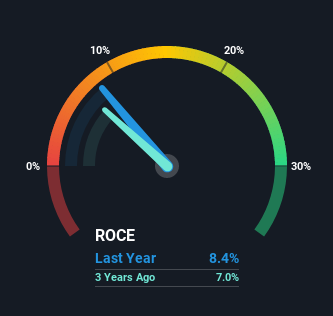- United States
- /
- Electric Utilities
- /
- NasdaqGS:OTTR
Returns At Otter Tail (NASDAQ:OTTR) Appear To Be Weighed Down

Finding a business that has the potential to grow substantially is not easy, but it is possible if we look at a few key financial metrics. Ideally, a business will show two trends; firstly a growing return on capital employed (ROCE) and secondly, an increasing amount of capital employed. If you see this, it typically means it's a company with a great business model and plenty of profitable reinvestment opportunities. In light of that, when we looked at Otter Tail (NASDAQ:OTTR) and its ROCE trend, we weren't exactly thrilled.
Return On Capital Employed (ROCE): What is it?
Just to clarify if you're unsure, ROCE is a metric for evaluating how much pre-tax income (in percentage terms) a company earns on the capital invested in its business. Analysts use this formula to calculate it for Otter Tail:
Return on Capital Employed = Earnings Before Interest and Tax (EBIT) ÷ (Total Assets - Current Liabilities)
0.084 = US$183m ÷ (US$2.7b - US$483m) (Based on the trailing twelve months to June 2021).
So, Otter Tail has an ROCE of 8.4%. In absolute terms, that's a low return, but it's much better than the Electric Utilities industry average of 4.6%.
See our latest analysis for Otter Tail

Above you can see how the current ROCE for Otter Tail compares to its prior returns on capital, but there's only so much you can tell from the past. If you'd like, you can check out the forecasts from the analysts covering Otter Tail here for free.
What Does the ROCE Trend For Otter Tail Tell Us?
The returns on capital haven't changed much for Otter Tail in recent years. The company has employed 34% more capital in the last five years, and the returns on that capital have remained stable at 8.4%. This poor ROCE doesn't inspire confidence right now, and with the increase in capital employed, it's evident that the business isn't deploying the funds into high return investments.
In Conclusion...
As we've seen above, Otter Tail's returns on capital haven't increased but it is reinvesting in the business. Since the stock has gained an impressive 82% over the last five years, investors must think there's better things to come. However, unless these underlying trends turn more positive, we wouldn't get our hopes up too high.
On a separate note, we've found 1 warning sign for Otter Tail you'll probably want to know about.
For those who like to invest in solid companies, check out this free list of companies with solid balance sheets and high returns on equity.
If you decide to trade Otter Tail, use the lowest-cost* platform that is rated #1 Overall by Barron’s, Interactive Brokers. Trade stocks, options, futures, forex, bonds and funds on 135 markets, all from a single integrated account. Promoted
New: AI Stock Screener & Alerts
Our new AI Stock Screener scans the market every day to uncover opportunities.
• Dividend Powerhouses (3%+ Yield)
• Undervalued Small Caps with Insider Buying
• High growth Tech and AI Companies
Or build your own from over 50 metrics.
This article by Simply Wall St is general in nature. We provide commentary based on historical data and analyst forecasts only using an unbiased methodology and our articles are not intended to be financial advice. It does not constitute a recommendation to buy or sell any stock, and does not take account of your objectives, or your financial situation. We aim to bring you long-term focused analysis driven by fundamental data. Note that our analysis may not factor in the latest price-sensitive company announcements or qualitative material. Simply Wall St has no position in any stocks mentioned.
*Interactive Brokers Rated Lowest Cost Broker by StockBrokers.com Annual Online Review 2020
Have feedback on this article? Concerned about the content? Get in touch with us directly. Alternatively, email editorial-team (at) simplywallst.com.
About NasdaqGS:OTTR
Otter Tail
Engages in electric utility, manufacturing, and plastic pipe businesses in the United States.
Adequate balance sheet average dividend payer.
Similar Companies
Market Insights
Community Narratives



